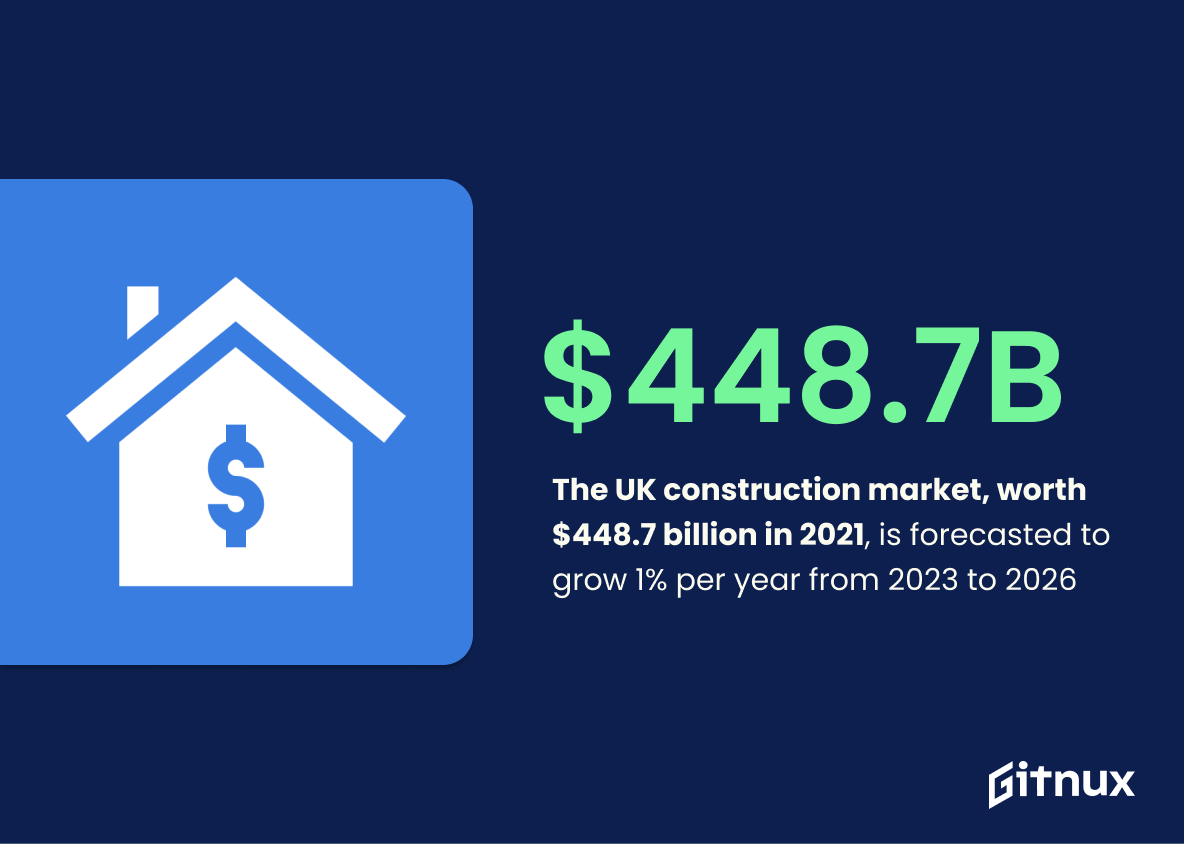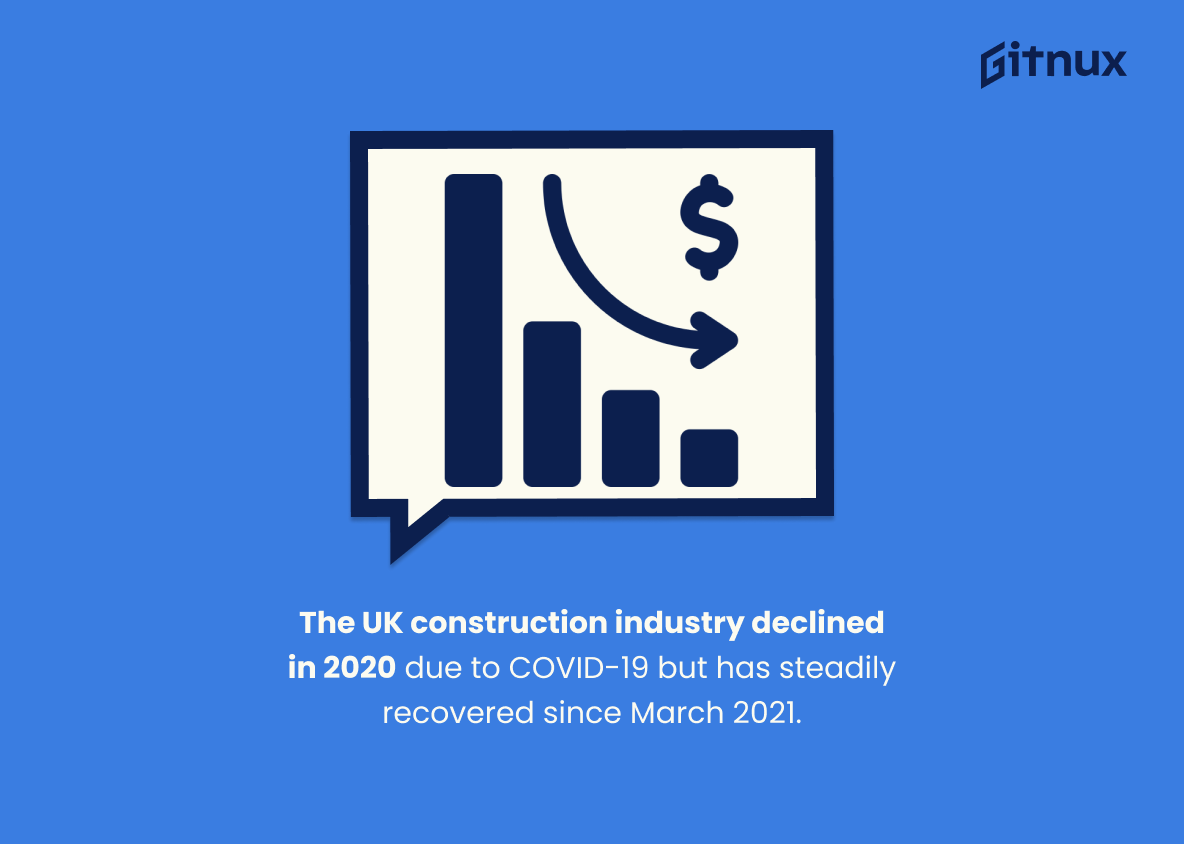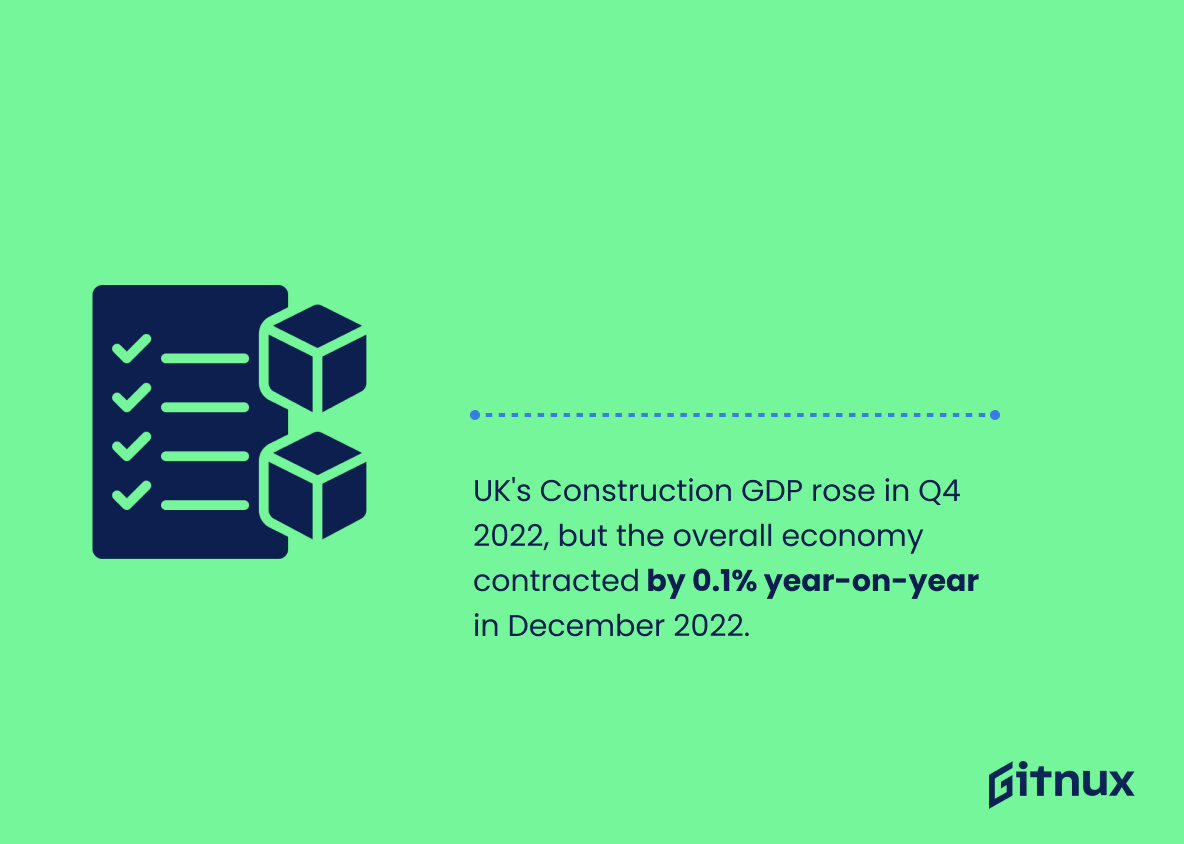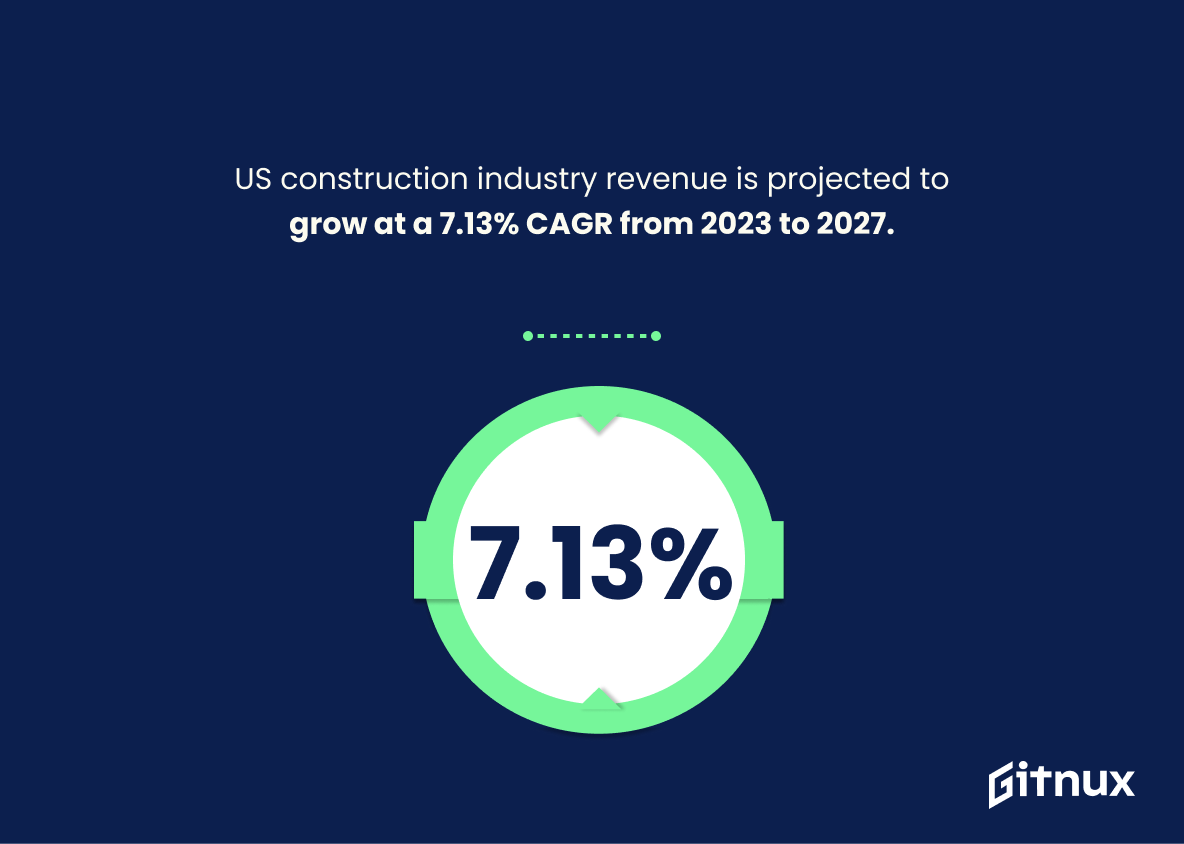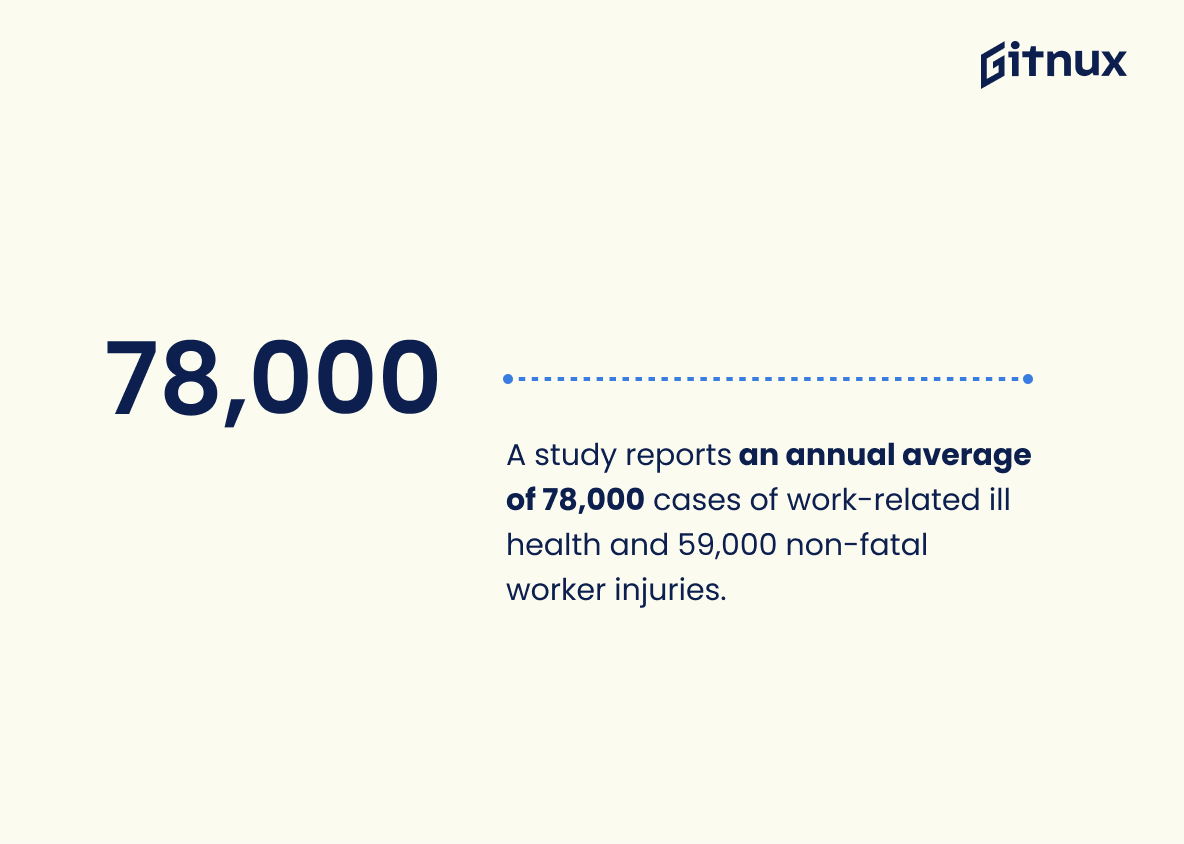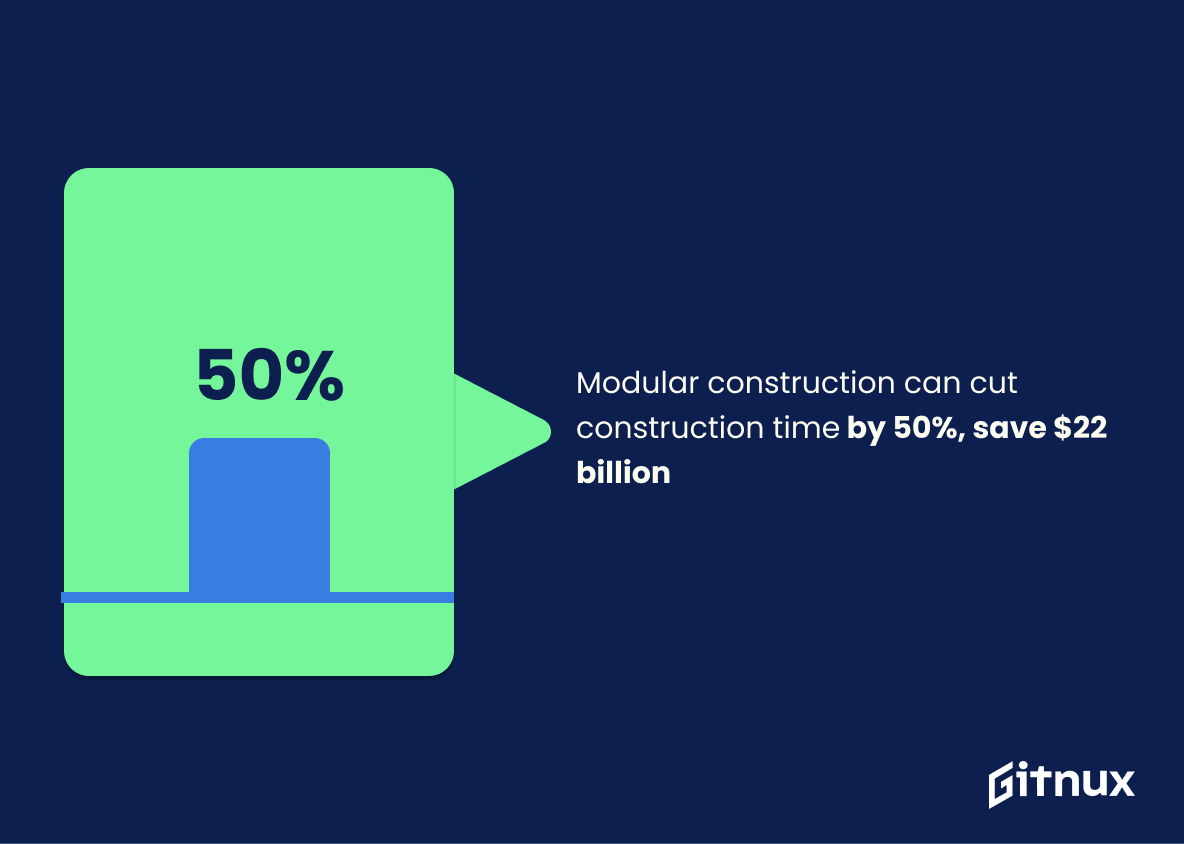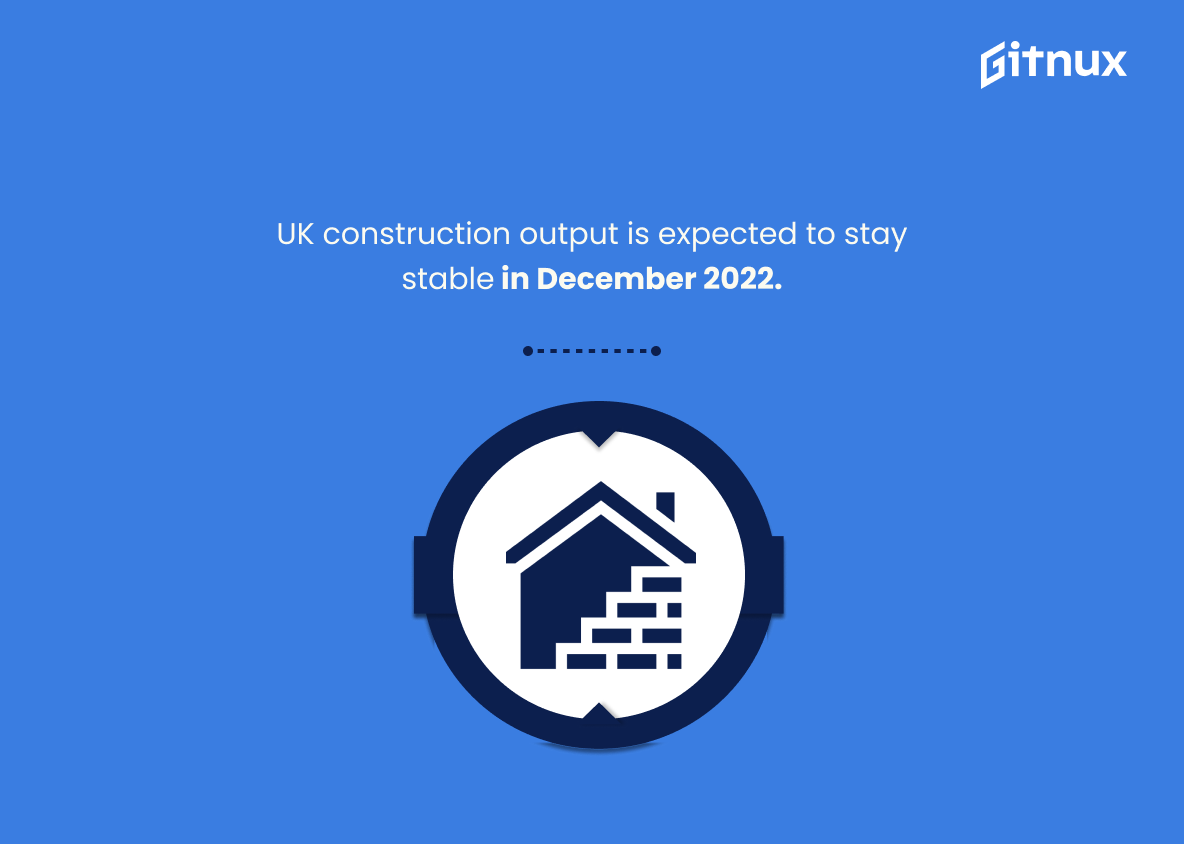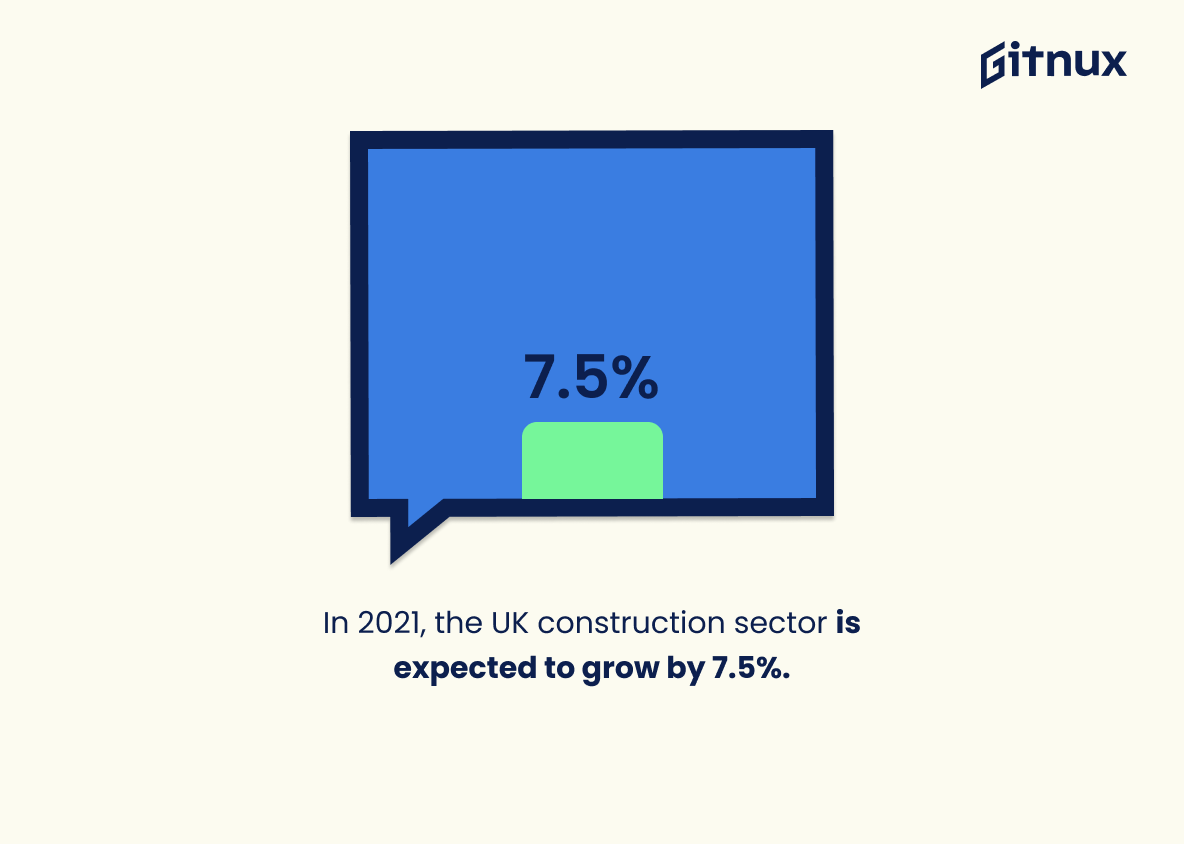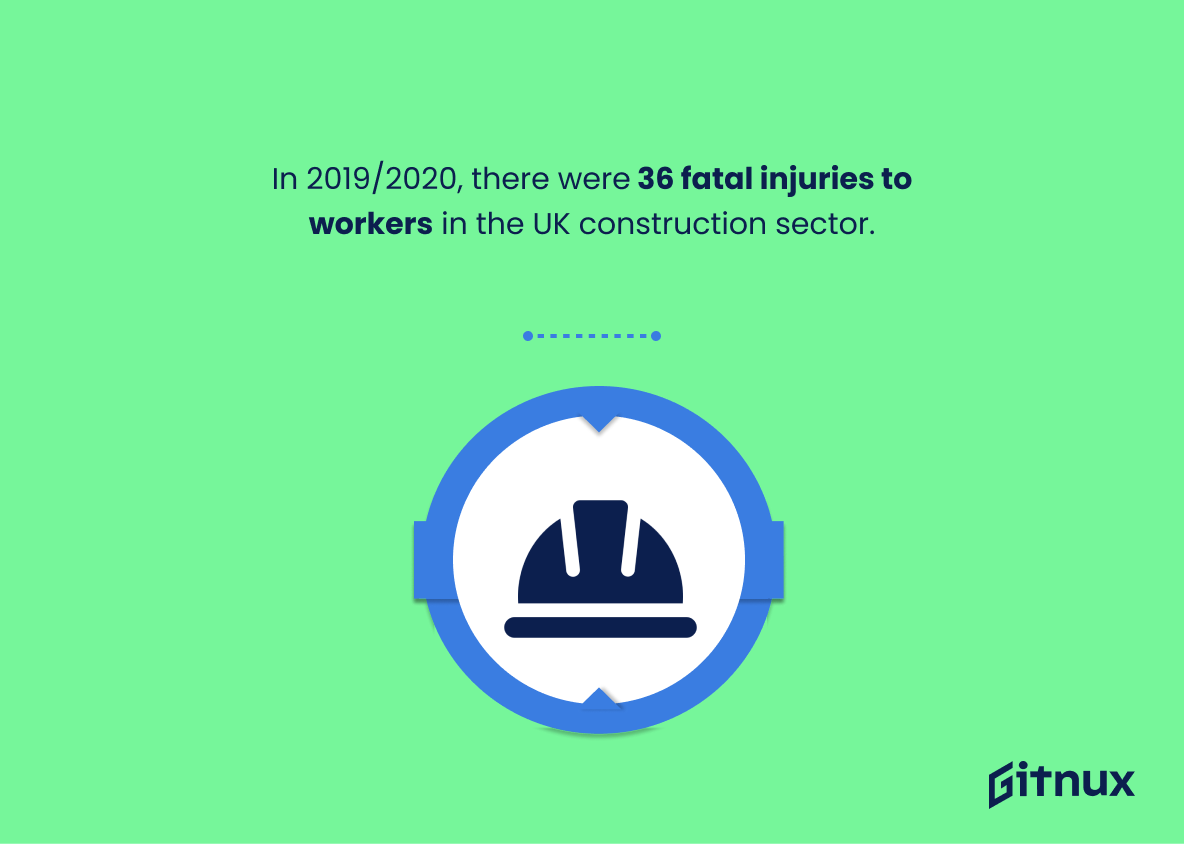The construction industry in the UK is an important part of the economy, contributing billions of pounds to the country’s GDP each year. It is also a major employer, with over two million people employed in the sector.
In this article, we will take a look at some of the key statistics related to the construction industry in the UK, including the size of the industry, its contribution to the economy, and the types of jobs that are available. We will also explore the challenges facing the industry, and the opportunities for growth in the future.
Construction Industry in the UK: Important Statistics
Revenue in the US Construction Industry is projected to increase by 7.13% CAGR from 2023-2027 and was valued at around 1.6 trillion US dollars in 2021.
A study shows that 78,000 workers suffer from work-related ill health and 59,000 non-fatal injuries to workers each year on average, with no statistically significant difference from the previous period.
Construction Industry in the UK: Statistics Overview
The UK construction market was valued at $448.7 billion in 2021, and is expected to grow at an annual average rate of 1% between 2023 and 2026, driven by investments in transport, energy, housing, health, education, and telecommunication infrastructure projects.
The industry is growing and is expected to continue to grow in the coming years. This growth is driven by investments in infrastructure projects, which will help to create jobs and stimulate economic activity.
Furthermore, it highlights the importance of the residential sector in the UK construction market, which accounted for the highest construction output value in 2021.
The UK construction industry experienced a significant decrease in 2020 due to the COVID-19 pandemic, however, there has been a steady recovery since March 2021.
Rising energy and oil prices have caused an increase in the cost of construction materials, driving up the overall cost of construction. This information is important for those in the industry to understand the current state of the market and plan for the future.
The UK’s GDP from Construction increased in the fourth quarter of 2022, but the British economy contracted 0.1% year-on-year in December of 2022, and was 0.8% below its pre-coronavirus level.
The UK’s Construction industry is still recovering from the effects of the coronavirus pandemic, and that the economy is still not back to its pre-pandemic levels. This could have implications for the industry in terms of investment and job creation.
Construction output in the UK is over £110 billion per annum and contributes 7% of GDP, with the majority of output coming from the private sector. It is comprised of three main sectors (commercial and social, residential, and infrastructure) and is split between new build (60%) and refurbishment and maintenance (40%).
It also highlights the diversity of the industry, which includes activities ranging from mining and quarrying to the construction of infrastructure and buildings.
Revenue in the US Construction Industry is projected to increase by 7.13% CAGR from 2023-2027 and was valued at around 1.6 trillion US dollars in 2021.
This shows the potential growth of the industry in the US, which can be used as a benchmark for the UK. It also provides an indication of the size of the US market and the potential for growth in the UK.
Construction output in the UK is forecast to rise by 2.8% in 2022 and 2.2% in 2023, however this is a sharp revision downward from the 4.3% and 2.5% forecast in Winter due to rising energy costs, commodity prices and inflation.
Despite the current strong levels of construction activity, the industry is likely to be affected by external factors such as rising energy costs, commodity prices and inflation.
This could have a significant impact on the industry in the UK, as it could lead to cost inflation on construction products and a decrease in demand for construction services.
The study shows that between 2015 and 2021, 54,964 injuries on construction sites required medical attention, with 44% of all accidents and 35% of fatal accidents being attributed to ‘falling to different levels’ and ‘struck by’ cases. These two types of injuries cost over R1bn or 44% of the total cost of injuries.
This highlights the importance of safety in the construction industry in the UK, as the costs associated with accidents can be high, both in terms of human impact and financial impact.
A study shows that 78,000 workers suffer from work-related ill health and 59,000 non-fatal injuries to workers each year on average, with no statistically significant difference from the previous period.
This highlights the need for employers to ensure that their workers are safe and healthy, and to take necessary steps to reduce the risk of work-related ill health and injuries.
Modular construction can reduce construction time by 50%, cost savings of $22B, reduce waste, and increase efficiency, and is set to become the new way of working in the construction industry by 2023.
Modular construction is a viable option for the industry to reduce costs, increase efficiency, and reduce waste, which could help address the major skills and housing shortages in the UK.
Construction output in the UK is estimated to be flat in December 2022, with increases in non-housing repair and maintenance and infrastructure new work offset by decreases in private housing repair and maintenance and private new housing.
This statistic matters because it provides insight into the current state of the construction industry in the UK and can be used to inform future decisions and strategies.
Supplementary Statistics
The UK construction industry contributed £117 billion to the UK economy in 2018.
This statistic is a powerful reminder of the importance of the construction industry in the UK and its potential to continue to be a major contributor to the UK economy in the future.
In 2021, the UK construction sector is expected to grow by 7.5%.
It is an encouraging sign for the industry, as it indicates that the sector is likely to remain a key contributor to the UK economy. Furthermore, this statistic is important for those interested in the construction industry in the UK, as it provides an insight into the current state of the sector and its potential for growth in the coming year.
In 2019, the construction industry employed approximately 2.4 million people in the UK.
This demonstrates the sheer number of people employed in the sector, highlighting the impact it has on the economy and the lives of those employed in it. It is a key piece of information that should be taken into account when discussing the construction industry in the UK.
As of 2021, the UK construction industry has over 370,000 businesses.
This serves as a reminder of the vast number of people employed in the industry, and the potential for growth and development in the sector.
In 2019/2020, there were 36 fatal injuries to workers in the UK construction sector.
Thus, there is a need for improved safety measures and regulations to ensure that workers in this sector are adequately protected from harm. It also serves as a reminder of the importance of taking all necessary precautions when working in this industry, as even one fatality is one too many.
Approximately 63,000 non-fatal injuries to workers were reported in the UK construction sector in 2019/2020.
Employers need to ensure that their workers are provided with the necessary safety equipment and training to reduce the risk of injury. It also serves as a reminder of the importance of having effective health and safety protocols in place to protect workers from harm.
In 2018, new construction orders in the UK reached a value of £61.7 billion.
This highlights the significant investment that was made in the sector, demonstrating the confidence of businesses and individuals in the industry’s ability to deliver. This is an important indicator of the health of the construction industry in the UK, and provides a valuable insight into the current state of the sector.
In 2019, housing accounted for 39% of total construction output in the UK.
The construction of new homes is a major contributor to the overall output of the industry, and thus is a key factor in its success. This is especially pertinent in the current climate, where the demand for housing is high and the need for new homes is pressing. As such, this statistic serves as a reminder of the importance of the housing sector in the UK construction industry, and the need to ensure that it remains a priority.
The construction output index in the UK reached a peak of 116.3 in October 2019.
It is a significant milestone, as it indicates that the industry was performing at its highest level in the past year. This is an important indicator of the health of the construction industry in the UK, and provides valuable insight into the current state of the sector.
In 2020, the construction sector contributed 5.5% to the UK’s Gross Domestic Product (GDP).
The sector is a major contributor to the country’s GDP, and is a key driver of economic growth. This highlights the need for continued investment in the sector, in order to ensure that it remains a major contributor to the UK’s economic success.
Around 65% of construction companies in the UK are micro-sized businesses with fewer than 10 employees.
This is significant as it implies that the industry is highly competitive, with a large number of businesses vying for a limited number of contracts. Furthermore, it suggests that the industry is largely reliant on the success of these small businesses, making it important to ensure that they are supported and given the resources they need to succeed.
In the first quarter of 2021, construction output increased by 3.7% in the UK.
It shows that the sector is growing and that the UK is investing in the construction industry. This is a positive sign for the economy and for the people who work in the industry, as it means more jobs and more opportunities. It also shows that the UK is taking steps to improve the infrastructure and the quality of life for its citizens. This statistic is a testament to the progress that the UK is making in the construction industry and is a great example of the potential that the sector has.
In 2020, British construction firms experienced a decline in productivity by 12.5% due to the COVID-19 pandemic.
The industry needs to adapt to the new normal and find ways to increase productivity despite the challenges posed by the pandemic. This statistic is an important indicator of the current state of the industry and can be used to inform decisions about how to move forward in the future.
In 2020, the UK private housing construction output decreased by 25.4%.
This statistic highlights the need for the industry to take steps to recover from the losses incurred in 2020 and to ensure that the sector is able to remain resilient in the face of future challenges.
Construction contributed to over 250,000 apprenticeships in the UK between 2017 and 2018.
It demonstrates the industry’s commitment to providing opportunities for young people to gain valuable skills and experience, and to helping them to build successful careers. This is an important factor in the continued growth and success of the construction industry in the UK.
The UK construction sector is expected to reach a 10% market share of the global offsite manufacturing industry by 2025.
By 2025, the sector is expected to have a 10% market share, indicating that the UK is well on its way to becoming a leader in this field. This is an important milestone for the industry, as it shows that the UK is making strides towards becoming a major player in the global offsite manufacturing industry.
In 2020, construction firms in London accounted for 17% of the UK’s construction output.
The capital is a major contributor to the UK’s construction output, accounting for a significant proportion of the total. This is an important point to consider when discussing the construction industry in the UK, as it demonstrates the importance of London in the sector.
Conclusion
The UK construction industry is a major contributor to the UK economy and is expected to continue to grow in the coming years. The industry is highly competitive, with a wide range of companies competing for contracts. The industry is also highly regulated, with a number of government initiatives in place to ensure that construction projects are completed safely and to the highest standards.
The UK construction industry is a major employer, with over 2 million people employed in the sector. The industry is also a major consumer of materials, with an estimated £50 billion spent on materials each year. The UK construction industry is an important part of the UK economy and is expected to continue to grow in the coming years.
References
1 – https://www.globaldata.com/store/report/uk-construction-market-analysis/#:~:text=The%20UK%20construction%20market%20size,1%25%20between%202023%20and%202026.
2 – https://www.mordorintelligence.com/industry-reports/united-kingdom-construction-market
3 – https://tradingeconomics.com/united-kingdom/gdp-from-construction#:~:text=GDP%20from%20Construction%20in%20the%20United%20Kingdom%20averaged%2030433.02%20GBP,the%20second%20quarter%20of%202020. and/or https://tradingeconomics.com/united-kingdom/gdp-growth
4 – https://www.designingbuildings.co.uk/wiki/UK_construction_industry
5 – https://www.statista.com/outlook/io/construction/united-kingdom
6 – https://www.nfrc.co.uk/docs/default-source/members_bulletin_content/cpa-construction-industry-forecasts-spring-2022.pdf
7 – https://www.bizcommunity.com/Article/196/494/227275.html#:~:text=For%20the%20period%202015%20to,injured%20on%20construction%20sites%20daily.
8 – https://www.hse.gov.uk/statistics/industry/construction.pdf
9 – https://www.sablono.com/solutions/construction-trends?utm_term=construction%20industry%20trends&utm_campaign=Solution+page+-+Construction+trends+-+Search&utm_source=adwords&utm_medium=ppc&hsa_acc=9333612983&hsa_cam=19740594939&hsa_grp=145186933654&hsa_ad=649668959964&hsa_src=g&hsa_tgt=kwd-687171286&hsa_kw=construction%20industry%20trends&hsa_mt=p&hsa_net=adwords&hsa_ver=3&gclid=CjwKCAiAu5agBhBzEiwAdiR5tI6mM0B0oKRDzHPFbSkOQrHqa1czr-KoZ4TusbgfMdB4YnOlKG0NJBoCKR8QAvD_BwE
10 – https://www.ons.gov.uk/businessindustryandtrade/constructionindustry/bulletins/constructionoutputingreatbritain/constructionoutputingreatbritaindecember2022newordersandconstructionoutputpriceindicesoctobertodecember2022
11 – https://www.pinsentmasons.com
12 – https://www.fenews.co.uk
13 – https://www.ibisworld.com
14 – https://www.ons.gov.uk
15 – https://www.constructionglobal.com
16 – https://www.buildington.co.uk
17 – https://www.statista.com
18 – https://www.ceicdata.com
19 – https://www.hse.gov.uk
